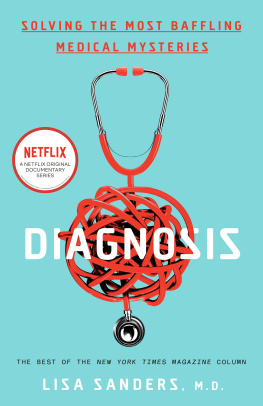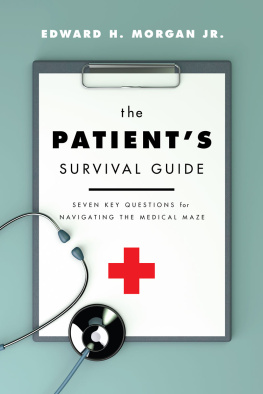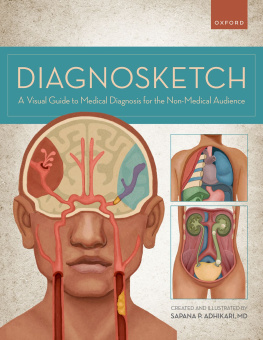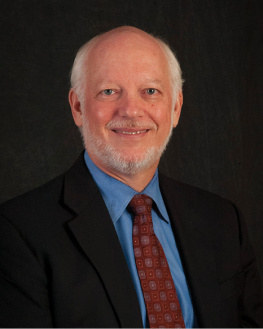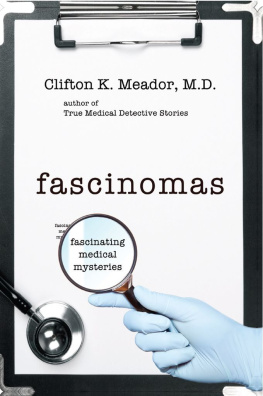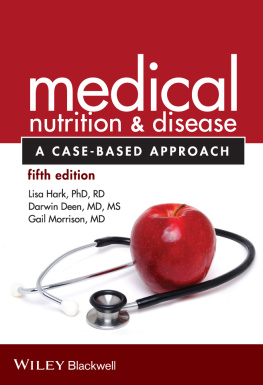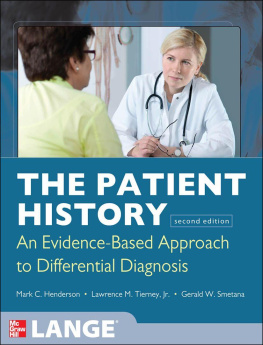Lisa Sanders - Every Patient Tells a Story: Medical Mysteries and the Art of Diagnosis
Here you can read online Lisa Sanders - Every Patient Tells a Story: Medical Mysteries and the Art of Diagnosis full text of the book (entire story) in english for free. Download pdf and epub, get meaning, cover and reviews about this ebook. genre: Science. Description of the work, (preface) as well as reviews are available. Best literature library LitArk.com created for fans of good reading and offers a wide selection of genres:
Romance novel
Science fiction
Adventure
Detective
Science
History
Home and family
Prose
Art
Politics
Computer
Non-fiction
Religion
Business
Children
Humor
Choose a favorite category and find really read worthwhile books. Enjoy immersion in the world of imagination, feel the emotions of the characters or learn something new for yourself, make an fascinating discovery.

- Book:Every Patient Tells a Story: Medical Mysteries and the Art of Diagnosis
- Author:
- Genre:
- Rating:5 / 5
- Favourites:Add to favourites
- Your mark:
- 100
- 1
- 2
- 3
- 4
- 5
Every Patient Tells a Story: Medical Mysteries and the Art of Diagnosis: summary, description and annotation
We offer to read an annotation, description, summary or preface (depends on what the author of the book "Every Patient Tells a Story: Medical Mysteries and the Art of Diagnosis" wrote himself). If you haven't found the necessary information about the book — write in the comments, we will try to find it.
Lisa Sanders: author's other books
Who wrote Every Patient Tells a Story: Medical Mysteries and the Art of Diagnosis? Find out the surname, the name of the author of the book and a list of all author's works by series.
Every Patient Tells a Story: Medical Mysteries and the Art of Diagnosis — read online for free the complete book (whole text) full work
Below is the text of the book, divided by pages. System saving the place of the last page read, allows you to conveniently read the book "Every Patient Tells a Story: Medical Mysteries and the Art of Diagnosis" online for free, without having to search again every time where you left off. Put a bookmark, and you can go to the page where you finished reading at any time.
Font size:
Interval:
Bookmark:
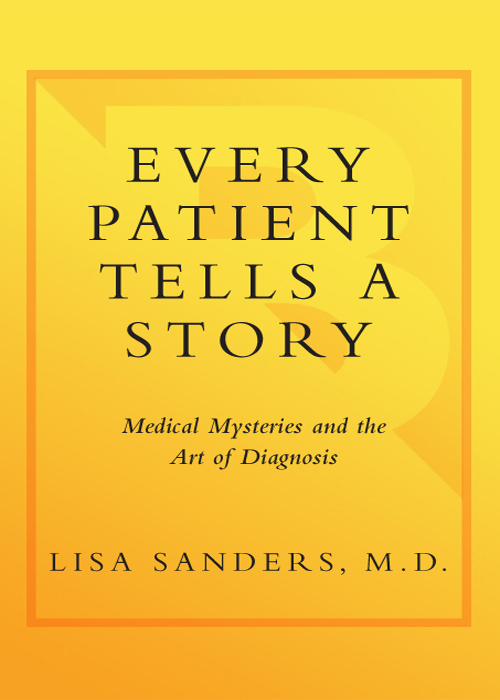
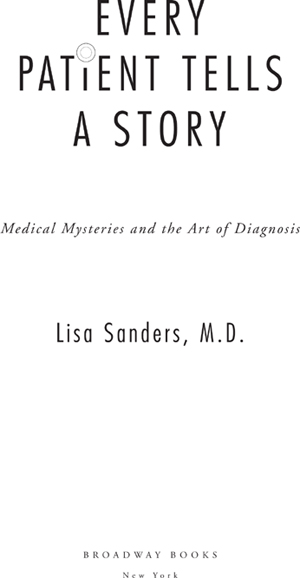
To Jack
PART ONE:
2.
PART TWO:
7.
PART THREE:
8.
PART FOUR:
The stories I tell here are real. In order to respect the confidentiality of these patients who were kind enough to share their stories with me, I have changed their names. In some instances I have altered certain identifying details as well. The doctors featured in these pages described in detail some of their most difficult diagnosesmistakes and all. They are distinguished not by these errors but by their willingness to discuss them. No one should be punished for simply being honest, and so I have changed the names of these brave doctors.
The use of pronouns when you are speaking of an individual remains problematic in writing now that we can no longer just use the generic he. There is no rule on this at this point, so in this book I will refer to the generic doctor as she and the generic singular patient as he.
Every Patients Nightmare
B arbara Lessing stared out the window at the snowy field behind the hospital. The afternoon sky was dark with yet more snow to come. She looked at the slender figure in the bed. Her daughter, Crystal, barely twenty-two years old and healthy her entire life, was nowsomehowdying. The young woman had been in the Nassau University Medical Center ICU for two days; shed been seen by a dozen doctors and had scores of tests, yet no one seemed to have the slightest idea of just what was killing her.
It all started at the dentists office. Crystal had had a couple of impacted wisdom teeth taken out the month before. But even after the teeth were gone, the pain persisted. Shed called her mother halfway across the state just about every day to complain. Call your dentist, shed urged her daughter. And she had. Finally.
The dentist gave her a weeks worth of antibiotics and then another. After that her mouth felt betterbut she didnt. She was tired. Achy. For the next week shed felt like she was coming down with something. Then the bloody diarrhea started. And then the fevers. Why didnt you go to the doctor sooner? the trim middle-aged woman scolded her daughter silently.
Barbara had gotten a call from a doctor in the emergency room of this suburban hospital the night before. Her daughter was ill, he told her. Deathly ill. She drove to Syracuse, caught the next flight to New York City, and drove to the sprawling academic medical center on Long Island. In the ICU, Dr. Daniel Wagoner, a resident in his second year of training, ushered her in to see her daughter. Crystal was asleep, her dark curly hair a tangled mat on the pillow. And she looked very thin. But most terrifying of allshe was yellow. Highlighter yellow.
Wagoner could feel his heart racing as he stood looking at this jaundiced wisp of a girl lying motionless on the bed. The bright unnatural yellow of her skin was shiny with sweat. She had a fever of nearly 103. Her pulse was rapid but barely palpable and she was breathing much faster than normal despite the oxygen piped into her nose. She slept most of the time now and when awake she was often confused about where she was and how she had gotten there.
To a doctor, nothing is more terrifying than a patient who is dying before your eyes. Death is part of the regular routine of the ICU. It can be a welcome relief to the patient, or to his family. Even a doctor may accept it for a patient whose life can be prolonged no longer. But not for a young girl who was healthy just weeks ago. These doctors had done everything they could think of but still there was a feara reasonable fearthat theyd missed some clue that could mean the difference between life and death for this young woman. She shouldnt die, but the young resident and all the doctors caring for her knew that she might.
Crystals thin chart was filled with numbers that testified to how very ill she was. Wagoner had been through the chart a dozen times. Virtually every test theyd run was abnormal. Her white blood cell count was very high, suggesting an infection. And her red blood cell count was lowshe had barely half the amount of blood she should have. Shed gotten a transfusion in the emergency room and another after she was moved to the ICU, but her blood count never budged. Her kidneys werent working. Her clotting system wasnt either. Her yellow skin was covered in bruises and her urine was stained deep red.
Sometimes, if you just work hard enough to keep a patient aliveto keep the blood circulating, the lungs oxygenating, the blood pressure high enoughthe body will be able to survive even a vicious illness. These are the miracles brought by technological advances. Sometimes, but not this time. The ICU team gave Crystal bag after bag of blood; they did their best to shore up her damaged clotting system; she got pressers (medications designed to increase blood pressure) and fluids to help her kidneys. She was on several broad-spectrum antibiotics. And yet none of that was enough. She needed a diagnosis. Indeed, she was dying for a diagnosis.
This book is about the process of making that diagnosis, making any diagnosis. So often this crucial linchpin of medicine goes unnoticed and undescribed, yet it is often the most difficult and most important component of what physicians do. As pervasive as medicine has become in modern life, this process remains mostly hidden, often misunderstood, and sometimes mistrusted. In movies and novels its usually the one-liner that separates the fascinating symptoms from the initiation of the life-saving therapy. On television its the contemporary version of Dr. McCoys (Star Trek) magic diagnostic device (his tricorder) that sees all, tells all. But in real life, the story of making a diagnosis is the most complex and exciting story that doctors tell. And these are stories that doctors tell. Just as Sherlock Holmes or Nick Charles (the hero of the Thin Man mysteries) or Gil Grissom (CSI) delights in explaining the crime to victims and colleagues, doctors take pleasure in recounting the completed story of their complex diagnoses, stories where every strange symptom and unexpected finding, every mystifying twist and nearly overlooked clue, finally fit together just right and the diagnosis is revealed. In this book Ill take you into those conversations and onto the front lines where these modern medical mysteries are solvedor sometimes not.
Just a hundred years ago, journalist and acerbic social critic Ambrose Bierce defined the word diagnosis in his Devils Dictionary as A physicians forecast of disease by [taking] the patients pulse and purse. And that was true for most of human history. Until very recently, diagnosis was much more art than science.
But since Ambrose Bierce wielded his rapier pen, there has been a revolution in our ability to identify the cause of symptoms and understand the pathology behind them. In the era in which Bierce wrote, Sir William Osler, considered by many to be the father of American medicine, was able to write a comprehensive summary of all the known diseases in his 1,100-page masterwork, The Principles and Practice of Medicine. These days each tiny sub-branch of medicine could provide as many pages on its super-specialized knowledge alone.
At the birth of medicine, millennia ago, diagnosis (the identification of the patients disease) and prognosis (the understanding of the diseases likely course and outcome) were the most effective tools a doctor brought to the patients bedside. But beyond that, little could be done to either confirm a diagnosis or alter the course of the disease. Because of this impotence in the face of illness, the consequences of an incorrect diagnosis were minimal. The true cause of the illness was often buried with the patient.
Font size:
Interval:
Bookmark:
Similar books «Every Patient Tells a Story: Medical Mysteries and the Art of Diagnosis»
Look at similar books to Every Patient Tells a Story: Medical Mysteries and the Art of Diagnosis. We have selected literature similar in name and meaning in the hope of providing readers with more options to find new, interesting, not yet read works.
Discussion, reviews of the book Every Patient Tells a Story: Medical Mysteries and the Art of Diagnosis and just readers' own opinions. Leave your comments, write what you think about the work, its meaning or the main characters. Specify what exactly you liked and what you didn't like, and why you think so.

